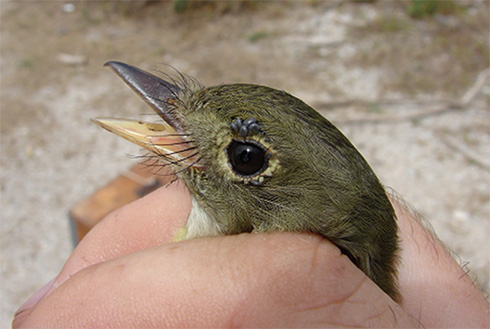Study shows migratory songbirds can carry ticks into the United States
COLLEGE STATION, Texas – When billions of songbirds make their yearly trip from their winter homes in South and Central America to North America, they are not alone. Some migratory songbirds pick up hitchhikers-specifically ticks, according to a study from researchers at the Texas A&M College of Veterinary Medicine & Biomedical Sciences (CVM) and the Smithsonian Conservation Biology Institute’s Migratory Bird Center.

Researchers screened songbirds in the springs of 2013 and 2014 at stopover sites along the Gulf of Mexico’s northern coast, where birds rest and feed during their northward migration. From this sampling, the study’s investigators estimated the number of neotropical ticks from South and Central America making their way into North America on songbirds as well as which birds were more likely to carry ticks.
The study, published in Applied and Environmental Microbiology, found 3.56 percent of the 3,844 birds sampled carried ticks, the majority of which were neotropical tick species. While this percentage may seem small, when extrapolated to all migratory songbirds making their way into North America annually, the researchers estimate over 19 million neotropical ticks are imported each spring.
“Even though birds carrying exotic ticks into Texas was a rare event-about 3 percent of the birds we sampled-this equates to a really large number of ticks when you consider that billions of birds move along this migratory path each spring,” said Dr. Sarah Hamer, assistant professor in Veterinary Integrative Biosciences at the CVM and an author on the study.
These ticks were not picky about which bird species they used as hosts. In fact, 36 of the 85 bird species sampled were tick carriers. “These ticks are generalists as larvae and nymphs,” said Hamer. “They can feed on a lot of different types of birds.”
Birds that were more likely to pick up ticks were those that foraged closer to the ground, according to the study. Ticks often drop onto the ground to enter their next life stage-from larva to nymph or from nymph to adult. This is when ticks seek a new host, making birds closer to the ground become more susceptible to becoming infected, said Hamer.
This tick transport could be cause for concern because of the pathogens ticks can carry. Of the ticks found of migratory birds, 29 percent carried one or more species of the bacteria Rickettsia, including some responsible for diseases such as Rocky Mountain spotted fever.
“What we found is that there are lots of diverse Rickettsia species found in ticks removed from migratory birds,” said Hamer. “Some are endosymbionts that are not known to have a negative impact on the tick or a human or an animal, but others are recognized pathogens, like spotted fever group
Rickettsia species that certainly can cause disease in people and animals if they get the opportunity to infect them.”
Additionally, researchers point out that many of the tick species found in the study are not native to the United States. “Most of these species are not typically found in the U.S., except one- Ambylomma maculatum, the Gulf Coast tick,” said Lisa Auckland, a research associate at the CVM and an author on the study.
Currently, most of the tick species found in this study do not have known established populations in the United States. However, researchers caution that ticks could establish populations in the United States in the future, given an ever-shifting environment and climate change.
“It’s good to be aware of this because our environment is constantly changing,” said Hamer. “Maybe some of those changes may result in an environment that’s warmer and more receptive to the establishment of these exotic ticks. Then, we may have new medical problems on our hands.” Further research is also needed to understand what happens after neotropical ticks make their way to the United States, she said.
###
Contact Information: Megan Palsa, mpalsa@cvm.tamu.edu, 979-862-4216, 979-421-3121 (cell)


